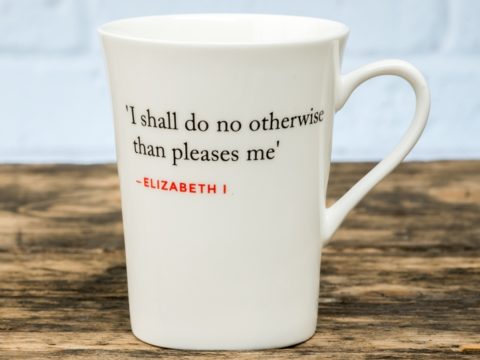James VI & I: Life Story
Chapter 17 : Union of the Crowns
James quickly made it plain that he wanted his Privy Council to comprise both English and Scots. The introduction of Scots, and the King’s desire to extend ‘denization’ (effectively citizenship) to all Scots in England, was a bit of a shock to Sir Robert Cecil, who had retained his place, and his colleagues, however, they had little choice but acceptance.
They were also somewhat disgruntled by his command to have Elizabeth’s jewels and clothes sent to Anne, protesting that the items should not be sent out of the country. James insisted that some be sent to her, although he mollified them by saying that he did not mean state jewellery to be sent so far away.
Anne and the older children joined the King in early summer, in time for King and Queen to be crowned together. Owing to an extremely virulent outbreak of plague, the coronation was a low key affair – not improved by Anne’s refusal to take Communion in the manner prescribed by the Anglican Church.
The factional politics of the English court were far less likely to break out into open violence than in Scotland. Nevertheless, there were bitter feuds and James, if he had been in doubt of their existence before his accession, soon became aware of them. He sought to heal one old wound by releasing the Earl of Southampton from the Tower, where he had been languishing since Essex’ Rebellion of 1600.
Although Cecil and Essex had been at loggerheads, and James was content for Cecil to be his Secretary, he spoke of Essex as his ‘martyr’, and he and Anne showed remarkable favour to Essex’ sister, Lady Penelope Rich, at least until she alienated the King by marrying against Church command. James also showed favour to those who had supported his mother.
James now sought to promote peace and unity on a larger scale – between his two, or rather, three (including Ireland) realms. One of his earliest acts was to proclaim Scots money as legal tender in England. Another was to order new coinage with the symbols of both nations.
In his first English Parliament of 1604, he declared his intention to oversee a wholesale union between the countries:
‘What God hath conjoined let no man separate. I am the husband and the whole isle is my lawful wife; I am the head and it is my body; I am the shepherd and it is my flock. I hope therefore that no man will think that I, a Christian King under the Gospel, should be a polygamist and husband to two wives.’
Nevertheless, he could not persuade either the English or the Scots to give more than ‘consideration’ to the matter. In particular, the English Parliament objected to the notion that Scots should have equal rights in England. There were concerns that a tide of ‘hungry Scots’ would wash its way over England. The point was eventually decided by the famous ‘Calvin’s Case 1608’, in which it was held by a majority of fourteen that Scots born after the King’s accession to the English throne had the same rights as Englishmen. Those born prior to 25th March 1603, remained ‘aliens.’
By 1605, it was reported by the Venetian Ambassador that
‘the question of the Union will, I am assured, be dropped; for His Majesty is now well aware that nothing can be effected, both sides displaying such obstinacy that an accommodation is impossible; and so his Majesty is resolved to abandon the question for the present, in hope that time may consume the ill-humours.’
Nonetheless, by Royal Proclamation, James changed his title and that of his successors, to King of Great Britain. He also sported two new coats of arms, with the 1 st and 4th quarters the Lion of Scotland when north of the border, and the English lions and lilies 1 st and 4th quarters in England. The Union flag, which was introduced (minus the Ulster saltire) gained little currency.
For the first few years, there was a good deal of disquiet, as many of James’ personal friends and servants, not surprisingly, were Scots and the King’s generosity – or rather prodigality, for he gave gifts and grants he could not afford – was resented. Over time, however, the English courtiers accepted that James was genuine in his desire to have both English and Scottish advisers and moderated their complaints.
During James’ years as King of Scots, he had cultivated good relationships with the Protestant countries of Europe – some of the German states and Scandinavia. The old Franco-Scottish alliance had worn thin (Henri IV was opposed to his succession to the English crown as it would remove France’s age-old strategy of keeping an enemyon England’s doorstep) but had endured. He was even on relatively good terms with Spain, although his moral, if not financial, support for the Netherlandish Protestant insurgents was not appreciated by the Spanish.
As King of England, he inherited an ongoing war with Spain, and a bloody and terrible war in Ireland that was dragging to a terrible conclusion with the final defeat of the Irish Earl, Hugh O’Neill, by Lord Mountjoy – rewarded by James with the Earldom of Devonshire. Following the increased control of Ireland, the policy of Anglo-Scottish ‘ plantations’ in the country, which had begun under Henry VIII, continued.
James immediately sought peace with Spain by withdrawing the ‘letters of marque’ from private vessels. A letter of marque was effectively a licence to prey on enemy shipping, although it frequently was no more than an excuse for outright piracy. The Treaty of London, bringing some twenty years of hostility with Spain to an end, was signed in 1604. James also ceased official support for the Netherlands, although, unlike the Spanish, they were still permitted to recruit in England amongst their fellow Protestants.



